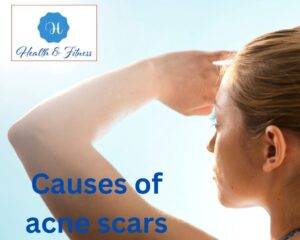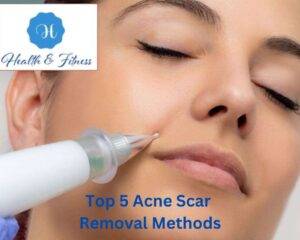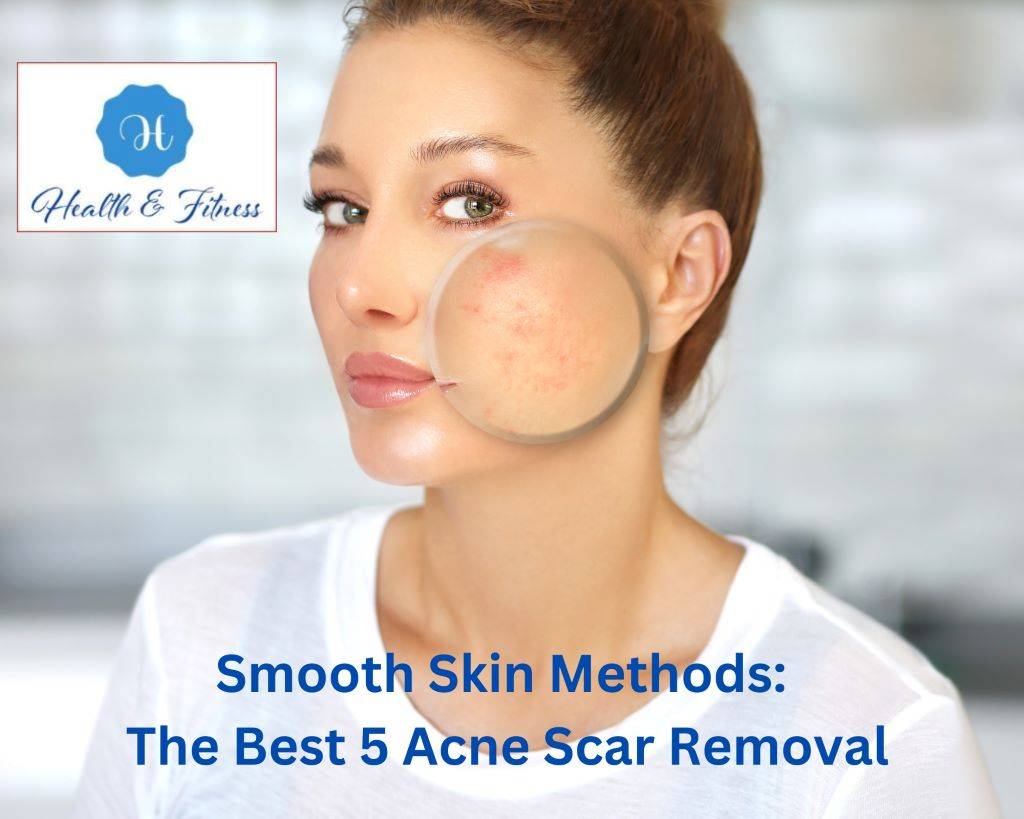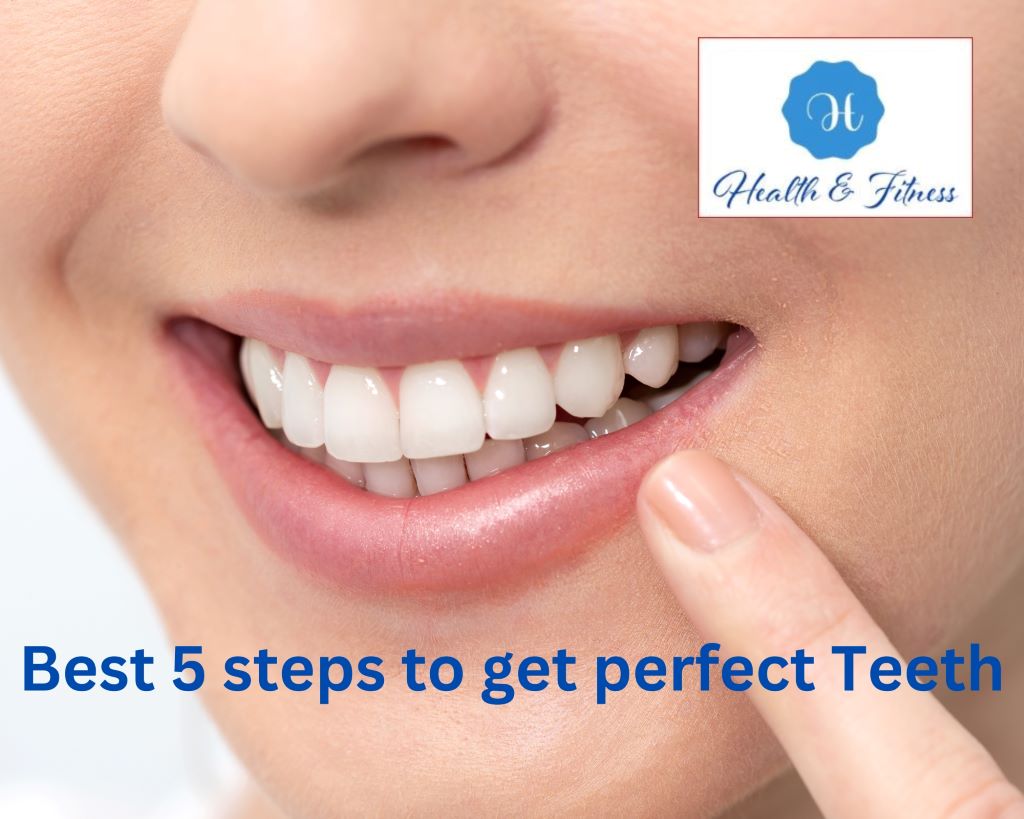Smooth Skin Methods: The Best 5 Acne Scar Removal
Unlock smooth skin with the top 5 acne scar removal methods. Bid farewell to scars for good with these effective solutions
Intorduction
They can also remind of a difficult time in someone’s life, especially if the acne was severe. Fortunately, various effective methods are available to help reduce or eliminate acne scars and achieve smoother, clearer skin.
This blog post will explore the best acne scar removal methods and provide a comprehensive guide on choosing the right one.
Whether you’re dealing with shallow scars, deep acne scars, or a combination of both, there’s sure to help you get the smooth, confident skin you deserve. So, let’s get started!
Definition of acne scars

Definition of acne scars
Acne scars are the physical markings or indentations left on the skin after a severe or persistent acne outbreak.
They occur when the skin is damaged and the body produces too little collagen, a protein that helps the skin heal and regenerate.
As a result, the skin can become indented, raised, or discoloured. Acne scars can range in size, shape, and depth and can be challenging to treat.
They can impact a person’s self-esteem and confidence, cause physical discomfort, and make it challenging to find makeup or skincare products that work for them.
Types of acne scars
Acne scars include:
Icepick scars
are deep, narrow scars that look like the skin has been punctured.
They are typically the result of severe acne breakouts.
Boxcar scars
are broader, more shallow scars with sharp edges.
They are often the result of severe acne that has caused the skin to break down and form a scar.
Rolling scars:
A wavelike appearance is caused by the skin’s underlying tissue being damaged, characterized by these scars. They are often the result of persistent acne breakouts.
Hypertrophic scars:
These are raised scars when the body produces too much collagen during healing. They are often red and bumpy and can be itchy or painful.
Post-inflammatory hyperpigmentation (PIH):
These dark or red marks occur when the skin’s pigment cells produce too much melanin in response to an injury, such as acne. They can be mistaken for scars, but unlike spots, PIH marks eventually fade on their own.
Not all acne scars are the same, and the best treatment option for one person may not be the best for another. An experienced dermatologist can help you determine the type of scars you have and recommend the best treatment options for your needs.
Causes of acne scars

Causes of acne scars
Severe or persistent acne outbreaks cause acne scars.
Acne can become inflamed and damaged when the skin is affected by acne.
The skin can become scarred if the acne is not treated correctly or is severe.
Several factors can contribute to the development of acne scars, including:
Picking or squeezing pimples:
When you pick or squeeze pimples, you can further damage the skin and increase the risk of scarring.
Severe acne breakouts:
The more powerful the acne breakout, the more likely it is to leave scars.
Genetics:
It genetically predisposes some people to develop acne scars.
Skin type:
People with oily skin are more likely to develop acne scars than dry skin.
Hormonal changes, such as during puberty, pregnancy, or menopause, can increase oil production and trigger acne breakouts.
Certain medications:
Certain medications, such as corticosteroids, can increase the risk of acne scarring.
Exposure to the sun:
Exposure to the sun can make acne scars darker and more noticeable.
Taking care of your skin and seeking acne treatment as soon as possible is essential to reduce the risk of scarring.
If you have scars, many therapies can lessen their appearance and improve your skin’s health.
Importance of proper treatment
Proper treatment of acne scars is essential for several reasons:
Improving appearance:
Acne scars can be unsightly and make you self-conscious about your appearance. Treatment can minimize scars and enhance skin appearance.
Boosting self-esteem:
Acne scars can hurt your self-esteem and confidence. Proper treatment can help you feel better about your appearance and boost your confidence.
Reducing physical discomfort:
Some acne scars can be itchy, painful, or touch-sensitive. Proper treatment can help reduce these symptoms and make your skin more comfortable.
Improving skin health:
Acne scars can cause damage to the skin, leading to other skin problems. Proper treatment can help improve the overall health and appearance of your skin.
Preventing future scarring: Proper treatment can help prevent and reduce the risk of new scars forming.
Improving makeup application:
If you have acne scars, applying makeup or finding skincare products that work for you may be difficult.
Proper treatment can help improve your skin’s texture and make applying makeup and other products more accessible.
Properly treating acne scars is essential for cosmetic and health reasons. With the proper treatment and care, you can improve the appearance of your skin and feel better about yourself.
Top 5 Acne Scar Removal Methods

Top 5 Acne Scar Removal Methods
1-Microneedling:
It creates microscopic skin punctures using fine needles.
This triggers the skin’s natural healing process, potentially reducing the visible effects of acne scars.
We typically do the procedure using a derma roller or a micro-needling pen.
We usually do the treatment over several sessions, and you can expect to see results after several weeks or months.
Step by step:
Cleanse your face thoroughly
Apply numbing cream to the affected area to minimize discomfort
Use a derma roller or microneedling pen to create tiny punctures in the skin
Apply a healing serum or cream to the treated area
Apply sunscreen to protect your skin from sun damage
2-Chemical Peels as acne scar removal:
Chemical peels are a type of exfoliating treatment that uses a solution to remove the top layer of dead skin cells.
Acne scars may become less noticeable, and the skin’s overall texture may improve.
Chemical peels have different strengths, and the type of peel you choose will depend on the severity of your acne scars.
Step by step:
Cleanse your face thoroughly
Apply numbing cream to the affected area to minimize discomfort
Apply the chemical peel solution to the affected area
Wait for the answer to take effect
Rinse the affected area with water
Apply a healing serum or cream to the treated area
Apply sunscreen to protect your skin from sun damage
3- Dermabrasion:
Dermabrasion is an exfoliating treatment that uses a unique tool to remove the top layer of dead skin cells. Acne scars could be less noticeable after doing this and improve the skin’s overall texture.
We typically do dermabrasion under local anesthesia, which can be a more invasive option than other treatments.
Step by step:
Cleanse your face thoroughly
Apply numbing cream to the affected area to minimize discomfort
Use a unique tool to remove the top layer of dead skin cells
Apply a healing serum or cream to the treated area
Apply sunscreen to protect your skin from sun damage
4- Acne scar removal by Laser Resurfacing:
Laser resurfacing uses a laser to remove the top layer of dead skin cells and stimulate the growth of new, healthy skin.
This can help make acne scars look less harmful and improve the skin’s overall texture.
There are different types of laser resurfacing, and your choice will depend on the severity of your acne scars.
Step by step:
Cleanse your face thoroughly
Apply numbing cream to the affected area to minimize discomfort
Use a laser to remove the top layer of dead skin cells and stimulate the growth of new,
healthy skin
Apply a healing serum or cream to the treated area
Apply sunscreen to protect your skin from sun damage
5- Fillers:
Fillers are an injectable treatment that uses a unique solution to fill in acne scars.
This can help reduce the appearance of scars and improve the skin’s overall texture.
Fillers come in different types; your choice will depend on the severity of your acne scars.
Step by step:
Cleanse your face thoroughly
Apply numbing cream to the affected area to minimize discomfort
Inject the filler solution into the affected area
Wait for the filler to take effect
Apply a healing serum or cream to the treated area
Apply sunscreen to protect your skin from sun damage
How to Choose the Right Method for You?
Choosing the proper acne scar removal method can be challenging, especially with many available options. Here are some things to consider when selecting the proper method for you:
The severity of Acne Scars:
Your acne scars will play a significant role in determining the best method for you. For mild acne scars, a chemical peel or microneedling may be enough.
You may need a more invasive treatment like dermabrasion or laser resurfacing for more severe scars.
Skin Type:
Your skin type will also play a role in determining which method is best for you. People with darker skin may be at a higher risk for scarring or discolourations from treatments like dermabrasion or laser resurfacing. Hence, it’s essential to consider your skin type when choosing a method.
Cost:
Acne scar removal treatments can be expensive, so it’s essential to consider your budget when choosing a method. Some medicines, like microneedling or chemical peels, are relatively affordable, while others, like laser resurfacing or fillers, can be much more expensive.
Recovery Time:
Consider how much downtime you’re willing to have. Some treatments, like chemical peels or micro-needling, may only require a few days of rest. In contrast, others, like dermabrasion or laser resurfacing, can take several weeks to recover from fully.
Results:
Consider the results you’re hoping to achieve. Some treatments, like fillers or laser resurfacing, may provide more immediate results, while others, like micro-needling or chemical peels, may take several weeks or months to show improvement.
Ultimately, the best way to determine which method suits you is to consult a dermatologist or skincare professional.
They can examine your skin and make recommendations based on your specific needs and goals. It’s important to remember that acne scar removal is a process and that you may need several treatments to achieve your desired results.
Conclusion
Acne scars can be a source of distress for many people, but many options are available for removing or reducing their appearance.
From chemical peels to laser resurfacing, there is a method to help you achieve smoother, clearer skin.
When choosing a method, it’s essential to consider your skin type, budget, recovery time, and desired results.
It’s also important to remember that acne scar removal is a process that may take several treatments to achieve the desired results.
Be patient and work with your dermatologist or skincare professional to determine the best plan for you. With the right approach, you can achieve the smooth, clear skin you deserve.
Final Recommendation
Achieving smooth, scar-free skin is possible and is within reach with the right approach and attitude. Here are a few words of encouragement to help you on your journey:
Believe that you can achieve the skin you desire.
With the right treatment plan and a positive attitude, you can overcome your acne scars and achieve the smooth, clear skin you deserve.
Be patient:
Acne scar removal is a process that may take several treatments to achieve the desired results. Be patient and trust.
Your dermatologist or skincare professional can guide you through the process and help you achieve your goals.
Take care of your skin:
Besides receiving treatments, taking care of your skin daily is essential.
This includes using gentle products, avoiding harsh ingredients, and protecting your skin from sun damage.
Stay positive:
Surround yourself with positive people and focus on what makes you happy. A positive attitude can go a long way in helping you achieve the results you desire.
Remember, you are not alone on this journey.
There are many people out there who have overcome their acne scars and achieved smooth,
clear skin.
With the right approach, you can too. So, keep moving forward and believe in yourself.
Your smooth, scar-free skin is waiting for you!
References
American Academy of Dermatology: The AAD is a professional organization for dermatologists that provides information and resources on skincare and treatments. They have a section on their website dedicated to acne and acne scars. https://www.aad.org/public/diseases/acne-and-rosacea/acne
Mayo Clinic: Mayo Clinic is a well-respected medical center that provides information and resources on various health topics, including skin care and acne scar removal. https://www.mayoclinic.org/diseases-conditions/acne/diagnosis-treatment/drc-20368048



